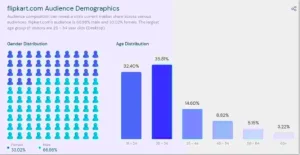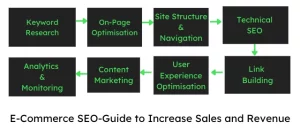E-Commerce SEO: Ultimate Guide to Increase Sales & Revenue
E-commerce SEO means to enhance online visibility and attract organic traffic, ultimately driving more potential customers to their platforms and increasing sales opportunities.
23.6% of ecommerce orders are directly linked to organic traffic. 44% of people start their online shopping with a search engine (Source).
E-commerce SEO improves online visibility for businesses and leads to increased organic traffic and potential customers. Businesses must adopt e-commerce SEO services to increase their audience reach and generate more revenue.
If you are planning to start your business online, knowing e-commerce marketing is important for you. Let us dive into the application of e-commerce SEO.
What is e-commerce SEO?
E-commerce SEO refers to optimising e-commerce websites to improve their visibility in search engine results and attract organic traffic. It involves various techniques and strategies such as keyword research, on-page optimization, technical optimization, link building, and content marketing to enhance the website’s search engine rankings and drive more targeted traffic to the online store.
The ultimate goal of e-commerce SEO is to increase online visibility, generate more qualified leads, and boost sales for the e-commerce business.
Read: How to do SEO for Small Business?
Brand Example of e-commerce SEO Strategy
Let us read the brand example of Flipkart.
Flipkart uses a mix of organic and paid means to get more organic traffic to the website and increased visibility. Flipkart’s audience is 66.98% male and 33.02% female.

According to the report published in Digital Scholar, Flipkart leads the show when it comes to SEO. The report states that Flipkart has amazing score in the following:
Organic Keywords = 22,811,205
Monthly Traffic = 236,950,666
Backlinks =70,000,000+
Domain Authority = 90
Source: Digital Scholar
Flipkart adopts these practices to lead the show:
- To pull the SEO show, Flipkart focuses on long-tail keywords instead of single words.
- Flipkart’s has dedicated their attention to user and mobile-friendly website.
- In another best example, Flipkart finds the most searched queries, selects the best ones and turns them into URLs for web pages.
- Flipkart uses third party platforms to run adverts and advertise on other websites. Some of the Flipkart’s active Ads:

- Flipkart involves remarketing to the potential customers and encourages them to buy across all the digital channels.
- As a part of ecommerce marketing strategy, Flipkart uses multiple channels for marketing. The major traffic for the e-commerce giant comes from targeting its competitor and retargeting. Some of the e-commerce marketing strategies used by Flipkart include:
- Offer free shipping
- Advertise
- Create landing pages
- Retarget
- Customer support
- Secure checkout process
- Offer easy return policy
Benefits of Enhanced E-Commerce
Enhanced e-commerce offers several benefits for businesses:
- Improved User Experience: Enhanced e-commerce platforms provide a user-friendly and streamlined shopping experience. They offer intuitive navigation, simplified checkout processes, personalized recommendations, and easy access to product information, enhancing customer satisfaction and increasing the likelihood of repeat purchases.
- Increased Sales and Conversions: Enhanced e-commerce features, such as cross-selling and upselling opportunities, personalised product recommendations, and effective product showcasing, contribute to higher sales and conversions. By providing a seamless and tailored shopping experience, businesses can effectively engage customers and drive them toward purchasing.
- Advanced Analytics and Insights: Enhanced e-commerce platforms typically come equipped with robust analytics tools that provide valuable insights into customer behaviour, purchasing patterns, and sales performance. This data allows businesses to make informed decisions, optimise their marketing strategies, and identify areas for improvement to maximise revenue and profitability.
- Effective Inventory Management: With enhanced e-commerce capabilities, businesses can efficiently manage their inventory. Real-time inventory tracking and management systems help prevent overselling or stockouts, ensuring customers access accurate stock information and reducing the likelihood of order cancellations or customer dissatisfaction.
- Expanded Market Reach: Enhanced e-commerce allows businesses to extend their market reach beyond geographical boundaries. With the ability to sell products globally and leverage digital marketing channels, businesses can reach a wider audience and tap into new market segments, opening up opportunities for growth and increased brand exposure.
- Integration with Marketing Channels: Enhanced e-commerce platforms often integrate with various marketing channels such as email marketing, social media, and search engine advertising. This integration enables businesses to create cohesive marketing campaigns, target specific customer segments, and drive traffic to their e-commerce website, ultimately boosting sales and brand visibility.
E-commerce SEO-Ultimate Guide to Increase Sales and Revenue
This is the ultimate guide to increase sales and revenue:

Keyword Research and Strategy:
- Identify relevant keywords: Conduct comprehensive keyword research to discover high-volume keywords related to your products or services.
- Competitive analysis: Analyse competitor keywords to gain insights and identify keyword gaps.
- Long-tail keywords: Target long-tail keywords with less competition but higher conversion potential.
- Keyword mapping: Assign target keywords to specific product pages or categories for optimal optimization.
On-Page Optimization:
- Title tags: Craft compelling and keyword-rich titles for each product page, keeping them within the recommended character limit.
- Meta descriptions: Write compelling meta descriptions that entice users to click and include relevant keywords.
- Header tags: Use appropriate header tags (H1, H2, H3) to structure content and highlight essential information.
- URL structure: Optimise URLs by incorporating target keywords and keeping them concise and readable.
- Keyword-rich content: Create unique, informative, and keyword-rich product descriptions and category pages.
- Image optimization: Optimise images by adding descriptive alt tags and compressing file sizes for faster loading speeds.
When you are working on e-commerce SEO, you must take care of these for the site structure and navigation:
- User-friendly design: Ensure your website has an intuitive, user-friendly design with easy navigation.
- Internal linking: Implement links between relevant pages to improve navigation and distribute link equity.
- Breadcrumb navigation: Use breadcrumb navigation to provide clear paths for users and search engines.
- XML sitemap: Create and submit an XML sitemap to search engines for efficient crawling and indexing.
Technical SEO:
Work on technical SEO to improve website’s performance:
- Site speed optimization: Optimise site loading speed by compressing images, enabling caching, and minifying CSS and JavaScript files.
- Mobile responsiveness: Ensure your e-commerce website is mobile-friendly and offers a seamless experience across different devices.
- Schema markup: Implement schema markup to enhance search engine understanding of your product details, ratings, and reviews.
- Canonical tags: Use canonical tags to avoid duplicate content issues and consolidate link equity.
Link Building:
Work on link building to bring in more traffic:
- High-quality backlinks: Focus on acquiring authoritative and relevant backlinks from reputable websites through guest blogging, influencer collaborations, or partnerships.
- Broken link building: Identify broken links on relevant websites and offer your content or products as a replacement.
User Experience Optimisation:
Make it easy for users for higher dwell time and good customer experience:
- Clear calls-to-action: Include clear and compelling calls-to-action throughout your e-commerce website to guide users towards desired actions.
- Simplified checkout process: Streamline your procedure to minimise friction and reduce cart abandonment rates.
- Personalization: Utilise personalised product recommendations and targeted marketing campaigns to enhance the user experience and drive conversions.
Content Marketing:
Once you have worked on SEO, you can start with content marketing to gain traffic to your website.
- Blogging: Create a blog and publish valuable and engaging content related to your products, industry, or customer interests.
- Guest blogging: Contribute guest posts to reputable websites within your niche to build brand visibility and attract backlinks.
- User-generated content: Encourage customers to leave reviews and testimonials, increasing social proof and user-generated content.
Analytics and Monitoring:
Monitoring website performance is important to fix the errors well in time:
- Install Google Analytics: Set up Google Analytics to track website traffic, user behaviour, conversions, and other vital metrics.
- Track conversions: Set up e-commerce tracking in Google Analytics to monitor sales, revenue, and conversion rates.
- Regular analysis: Analyse data, identify trends, and make data-driven decisions to optimise your SEO strategy.
Conclude:
With this ultimate guide to e-commerce SEO, you can drive more organic traffic, enhance user experience, and ultimately increase sales and revenue for your online store. Conduct thorough keyword research, optimise on-page elements, improve site structure and navigation, build high-quality backlinks, and prioritise user experience.
For further assistance in implementing these strategies or to discuss your specific e-commerce SEO needs, please get in touch with us at hello[at]noboruworld.com. Start boosting your e-commerce success today!
FAQ
How Can I Optimize My Product Descriptions for eCommerce SEO?
To optimize product descriptions for eCommerce SEO, focus on creating unique, informative, and compelling content for each product. Include relevant keywords naturally in the description, but avoid keyword stuffing.
Also provide details like product specifications, benefits, and usage instructions. User-generated content, such as reviews and ratings, can boost SEO by adding fresh, relevant content to product pages.
What Role Does Structured Data Markup Play in eCommerce SEO?
Structured data markup, often implemented using schema.org, helps search engines better understand your eCommerce website’s content. For product pages, you can use schema markup to provide information such as product prices, availability, ratings, and reviews.
This enhances the appearance of your listings in search results (rich snippets) and makes it easier for search engines to rank your products accurately, potentially increasing click-through rates.
How Can I Manage Duplicate Content Issues in eCommerce SEO?
Duplicate content can be a significant challenge in eCommerce due to similar product descriptions or multiple product variations. To manage this, you can use canonical tags to specify the preferred version of a page, preventing search engines from penalising you for duplicate content.
Create unique and valuable content for product pages, category descriptions, and blog posts. Implement 301 redirects for the same URLs and regularly check for and resolve duplicate content issues using SEO tools.



